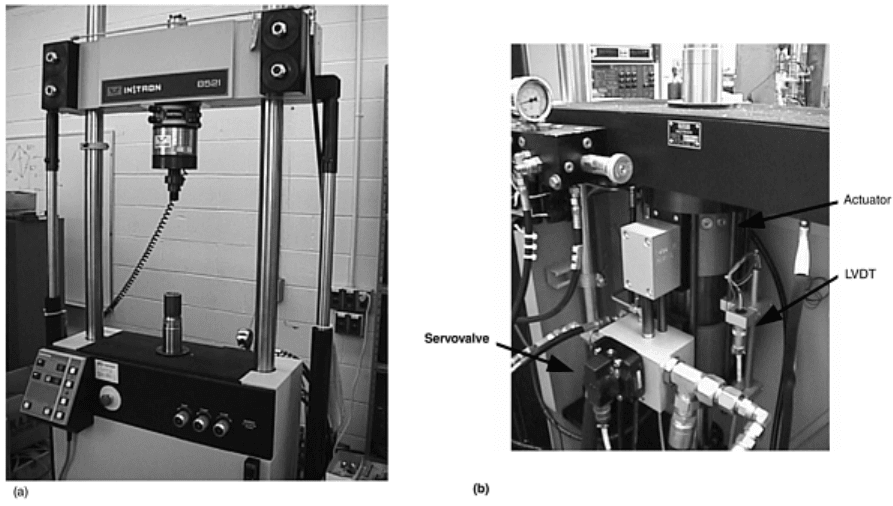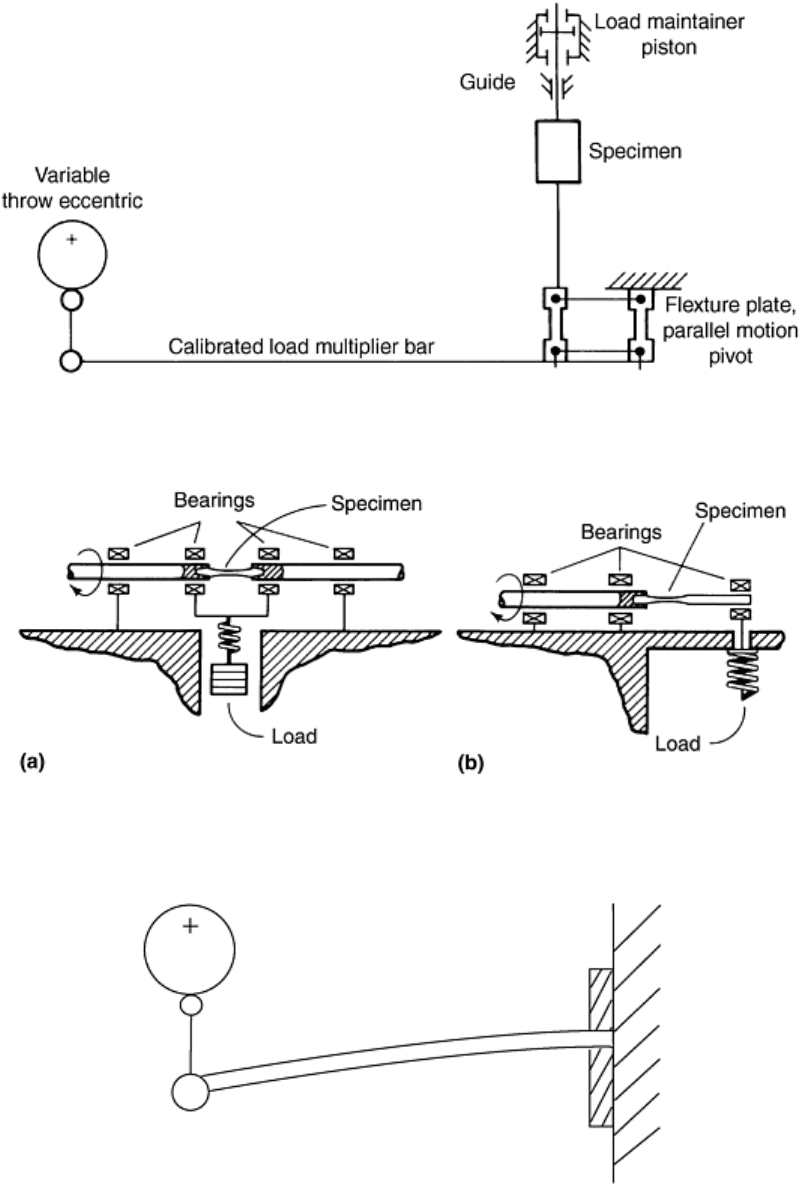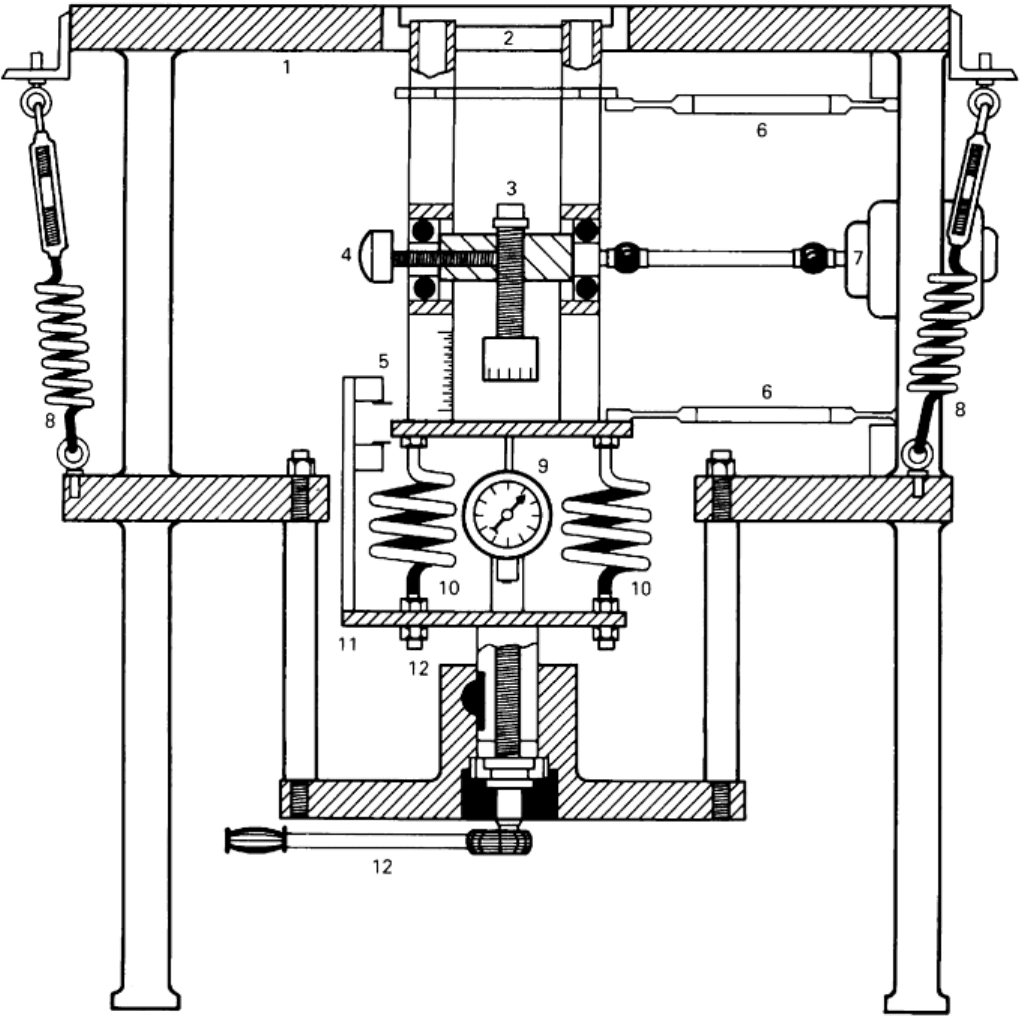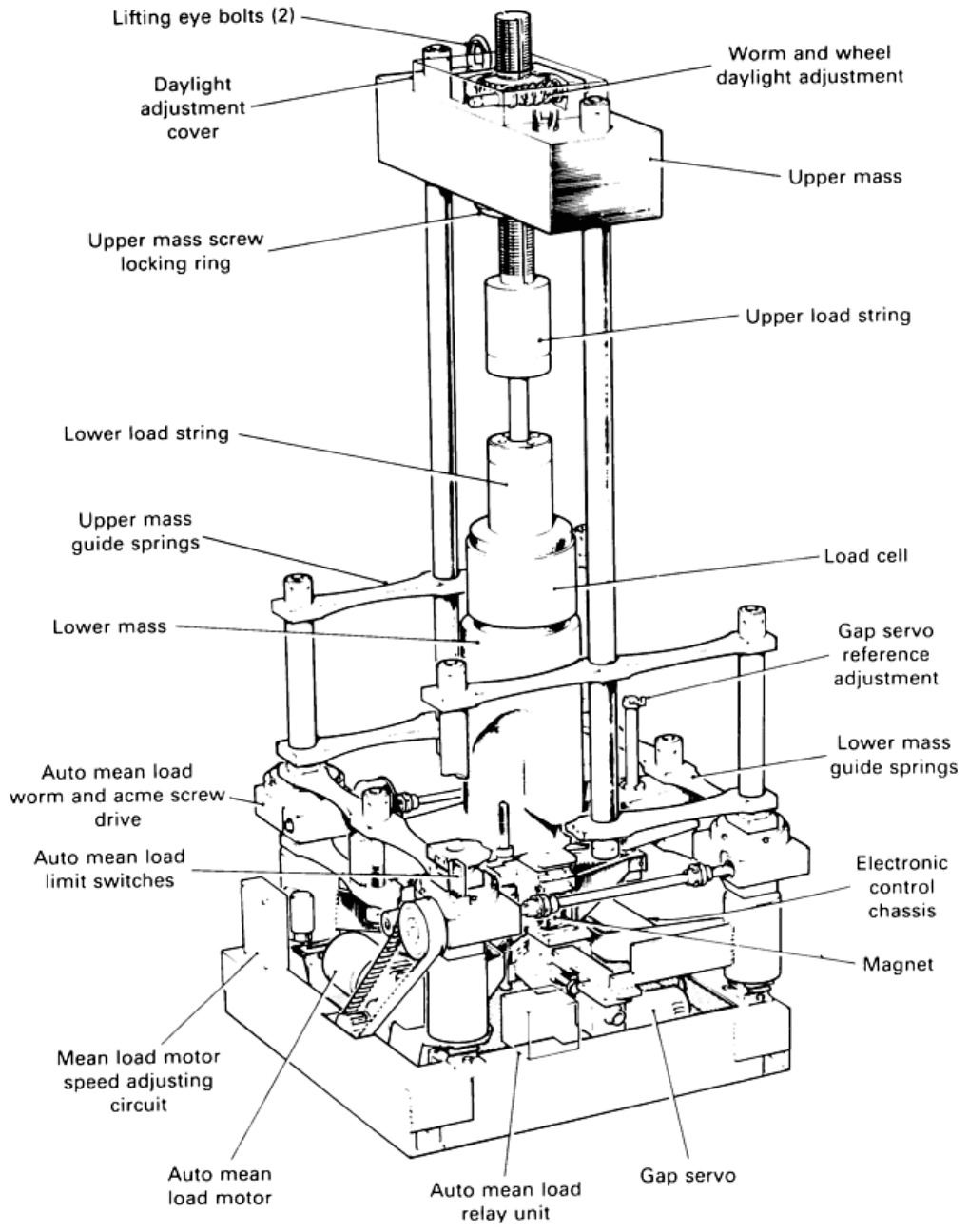ASM Metals HandBook Vol. 8 - Mechanical Testing and Evaluation
Подождите немного. Документ загружается.


region 2 to region 3 depends on the maximum stress-intensity factor, on the stress ratio, and on the fracture
properties of the material (Ref 8).
References cited in this section
7. J.M. Barsom, Fracture Mechanics—Fatigue and Fracture, Metals Handbook Desk Edition, 1985, p 32-2
to 32-7
8. S.T. Rolfe and J.M. Barsom, Fracture and Fatigue Control in Structures—Applications of Fracture
Mechanics, 3rd ed., ASTM, 1999
9. M.E. Taylor and J.M. Barsom, Effect of Cyclic Frequency on the Corrosion-Fatigue Crack-Initiation
Behavior of ASTM A 517 Grade F Steel, Fracture Mechanics: Thirteenth Conf., STP 743, ASTM, 1981
10. R. Roberts, J.M. Barsom, J.W. Fisher, and S.T. Rolfe, “Fracture Mechanics for Bridge Design,” FHWA-
RD-78-69, Federal Highway Administration, Office of Research and Development, July 1977
11. R.O. Ritchie, Near-Threshold Fatigue-Crack Propagation in Steels, Int. Met. Rev., Vol 24 (No. 5, 6),
1979
Fatigue and Fracture Mechanics
Acknowledgments
Sections of this article were adapted from several ASM Handbook articles, in particular those cited as Ref 1, 2,
3, 4 and 7.
References cited in this section
1. M.E. Fine and Y.-W. Chung, Fatigue Failure in Metals, Fatigue and Fracture, Volume 19, ASM
Handbook, ASM International, 1996, p 63–72
2. D.W. Hoeppner, Industrial Significance of Fatigue Problems, Fatigue and Fracture, Vol 19, ASM
Handbook, ASM International, 1996, p 3–4
3. E. Krempl, Design for Fatigue Resistance, Materials Selection and Design, Vol 20, ASM Handbook,
ASM International, 1997, p 516–532
4. D.W. Cameron and D.W. Hoeppner, Fatigue Properties in Engineering, Fatigue and Fracture, Vol 19,
ASM Handbook, ASM International, 1996, p 15–26
7. J.M. Barsom, Fracture Mechanics—Fatigue and Fracture, Metals Handbook Desk Edition, 1985, p 32-2
to 32-7
Fatigue and Fracture Mechanics
References

1. M.E. Fine and Y.-W. Chung, Fatigue Failure in Metals, Fatigue and Fracture, Volume 19, ASM
Handbook, ASM International, 1996, p 63–72
2. D.W. Hoeppner, Industrial Significance of Fatigue Problems, Fatigue and Fracture, Vol 19, ASM
Handbook, ASM International, 1996, p 3–4
3. E. Krempl, Design for Fatigue Resistance, Materials Selection and Design, Vol 20, ASM Handbook,
ASM International, 1997, p 516–532
4. D.W. Cameron and D.W. Hoeppner, Fatigue Properties in Engineering, Fatigue and Fracture, Vol 19,
ASM Handbook, ASM International, 1996, p 15–26
5. J.A. Bannantine, J.J. Comer, and J.L. Handrock, Fundamentals of Metal Fatigue Analysis, Prentice-
Hall, 1990
6. R.C. Juvinall, Engineering Considerations of Stress, Strain, and Strength, McGraw-Hill, 1967, p 274
7. J.M. Barsom, Fracture Mechanics—Fatigue and Fracture, Metals Handbook Desk Edition, 1985, p 32-2
to 32-7
8. S.T. Rolfe and J.M. Barsom, Fracture and Fatigue Control in Structures—Applications of Fracture
Mechanics, 3rd ed., ASTM, 1999
9. M.E. Taylor and J.M. Barsom, Effect of Cyclic Frequency on the Corrosion-Fatigue Crack-Initiation
Behavior of ASTM A 517 Grade F Steel, Fracture Mechanics: Thirteenth Conf., STP 743, ASTM, 1981
10. R. Roberts, J.M. Barsom, J.W. Fisher, and S.T. Rolfe, “Fracture Mechanics for Bridge Design,” FHWA-
RD-78-69, Federal Highway Administration, Office of Research and Development, July 1977
11. R.O. Ritchie, Near-Threshold Fatigue-Crack Propagation in Steels, Int. Met. Rev., Vol 24 (No. 5, 6),
1979
Fatigue, Creep Fatigue, and Thermomechanical
Fatigue Life Testing
Gary R. Halford and Bradley A. Lerch, Glenn Research Center at Lewis Field, National Aeronautics and Space
Administration; Michael A. McGaw, McGaw Technology, Inc.
Introduction
THE FATIGUE CRACK INITIATION RESISTANCE of an alloy is determined by conducting a series of tests
over a range of values of stress amplitude or strain range. The observed number of cycles to failure is plotted
against the stress amplitude or strain range to obtain a fatigue curve. The fatigue properties quoted for an alloy
are typically the constants used in the equation(s) that describe the fatigue curve. Fatigue lives of interest may
be as low as 10
2
or higher than 10
9
cycles. Because of the enormous scatter associated with fatigue, dozens of
tests may be needed to confidently establish a fatigue curve, and the cost may run into several thousands of
dollars. To further establish the effects on fatigue life of, for example, the test temperature, environment, alloy
condition, mean stress effects, creep-fatigue effects, and thermomechanical cycling, requires an extraordinarily

large and usually very costly test matrix. The total effort required to establish the fatigue resistance of an alloy
should not be taken lightly.
Fatigue crack initiation tests are conducted on relatively small—and presumed to be initially crack-free—
samples of an alloy that are intended to be representative of the metallurgical and physical condition of the
alloy. Generally, samples are smooth and have uniformly polished surfaces within the test section. Some may
have intentionally machined notches of well-controlled geometry, but the surface at the root of the notch is
usually not polished. The purpose of polishing is to attain a reproducible surface finish. This is to eliminate
surface finish as an uncontrolled variable. Test specimens are cyclically loaded until macroscopically
observable cracks initiate and eventually grow to failure. Normally, the fatigue failure life of a specimen is
defined as the number of cycles to separation of the specimen into two pieces. Alternative definitions are
becoming more common, particularly for low-cycle fatigue testing, wherein some prescribed indication of
impending failure due to cracking is adopted. Specific criteria will be described later. As a rule, cracks that
develop during testing are not measured, nor are the test parameters intentionally altered owing to the presence
of cracking. The topic of fatigue crack propagation testing of alloys is discussed in the articles“Fatigue Crack
Growth Testing” and “Creep Crack Growth Testing” in this Volume.
Microscopic-sized fatigue cracks tend to nucleate quite early in cyclic life (in the first 1–10%) in the high-
strain, plasticity-dominated, low-cycle life regime. In this regime, cyclic plasticity is widespread throughout the
specimen test section, and the range of plastic strain is used as a measure of the severity of fatigue “loading.”
On the other hand, cracks begin to appear quite late in cyclic life (90–99%) in the very low-strain, elastically
dominated, high-cycle life regime. There is a gradual transition between these two extremes of behavior for
intermediate strain ranges and cyclic lifetimes. In the high-cycle life regime, the cyclic behavior at the
macroscopic, phenomenological level is usually considered by design engineers to be linearly elastic and
thermodynamically reversible. It is important to recognize, however, that the micromechanisms of fatigue crack
nucleation and growth in metals and alloys are linked directly to the occurrence of reversed cyclic plasticity.
Fatigue will not occur without it. Even fatigue cracking that occurs in the range of a billion cycles to failure or
more must involve reversed plasticity. It is also important to recognize that the fatigue process is a progressively
degenerative one. For any given condition of cyclic loading that eventually leads to a fatigue failure, there is
some, though minute, permanent change from one cycle to the next. While the macroscopic behavior may
appear to be, for instance, linear, reversible, and elastic at the microstructural level, irreversible, nonlinear,
inelastic deformations occur in highly localized regions that accumulate until macroscopically observable
cracking occurs.
Although the results of crack initiation tests conducted on small specimens do not precisely establish the fatigue
life of a large part, such tests do provide useful information on the intrinsic fatigue crack initiation behavior of a
metal or alloy. As a result, such data can be utilized to develop engineering design criteria to prevent initiation
of fatigue cracks in structural components. The use of small-specimen fatigue test data is the basis of fatigue
design codes for pressure vessels; piping components; nuclear reactors; turbine blades; wheels; shafts; complex
welded, riveted, or bolted structures; automotive and off-highway equipment; exotic aerospace components;
and even soldered joints of lead-free electronic chips.
All alloys and metals in structural elements are susceptible to fatigue crack initiation if the structure is subjected
to sufficiently large and numerous amplitudes of cyclic loading.
Following a brief description of the phenomena of crack initiation and early growth, this article examines
specimen design and preparation as well as the apparatus used in crack initiation testing. Variables that
influence the resistance of alloys to fatigue crack initiation, such as the effect of mean and residual stress, stress
concentrations, stress amplitude, and surface properties, are briefly reviewed. The initial portion of this article
deals with fatigue testing of alloys in the regime wherein the isothermal temperature of testing is below the
range wherein behavior is significantly influenced by time-dependent mechanisms, such as creep, oxidation,
and metallurgical transformations. The testing procedures, instrumentation, and hardware must be altered to
accommodate creep-fatigue testing and thermomechanical fatigue testing, and these items will be addressed as
required throughout this article. Applicable ASTM standards for baseline fatigue testing are listed in Table 1.
Table 1 Applicable ASTM standards for baseline fatigue testing
Specification
No.
Title Comments

ASTM standards on fatigue testing methods
B 593 Bending Fatigue Testing for Copper-Alloy Spring
Materials
Cantilever bend testing methods
E 466 Conducting Force Controlled Constant Amplitude Axial
Fatigue Tests of Metallic Materials
Load controlled fatigue; no
measurement of strain
E 467 Verification of Constant Amplitude Dynamic Loads on
Displacements in an Axial Load Fatigue Testing System
Calibration of dynamic loads
under HCF
E 468 Presentation of Constant Amplitude Fatigue Test
Results for Metallic Materials
Reporting of load controlled
fatigue data
E 606 Strain-Controlled Fatigue Testing Fatigue testing using strain
measurement
E 739 Statistical Analysis of Linear or Linearized Stress-Life
(S-N) and Strain-Life (ε-N) Fatigue Data
Statistical analysis of fatigue life
curves
E 1049 Cycle Counting in Fatigue Analysis Cycle counting procedures for
spectrum loads
E 1823 Terminology Relating to Fatigue and Fracture Testing Definitions used in fatigue
testing
ASTM standards with equipments requirements
B 557 Tension Testing of Wrought and Cast Aluminum-and
Magnesium-Alloy Products
Lists specimen and grip designs
E 4 Force Verification of Testing Machines Calibration of load cells for test
frames
E 8 Tension Testing of Metallic Materials Lists specimen and grip designs
E 21 Elevated Temperature Tension Tests of Metallic
Materials
Guidance for elevated
temperature testing
E 74 Calibration of Force-Measuring Instruments for
Verifying the Force Indication of Testing Machines
Calibration of force standards
E 83 Verification and Classification of Extensometers Calibration and classes of
extensometers
E 1012 Verification of Specimen Alignment under Tensile
Loading
Load frame alignment and
measurement of bending strains
E 1237 Installing Bonded Resistance Strain Gages Installation of strain gages
E 1319 High-temperature Strain Measurement Use of high-temperature strain
gages
E 1856 Evaluating Computerized Data Acquisition Systems
Used to Acquire Data from Universal Testing Machines
Use and accuracy of
computerized data acquisition
systems
International and other national standards
(a)
ISO/DIS 12106,
1998
Metallic Materials—Fatigue Testing—Axial Strain-
Controlled Method
ISO 1099, 1975 Metals—Axial Load Fatigue Testing
ISO 1143, 1975 Rotating Bar Bending Fatigue Testing
ISO 1352, 1977 Steel—Torsional Stress Fatigue Testing
JIS Z 2279, 1992
Method of High Temperature Low Cycle Fatigue
Testing for Metallic Materials
DIN 51228,
1993
Fatigue Testing Machines—General Requirements
DIN 50113,
1982
Testing of Metals—Rotating Bending Fatigue Test
(a) Available in the US through Global Engineering Documents, Clayton, MO

Fatigue, Creep Fatigue, and Thermomechanical Fatigue Life Testing
Gary R. Halford and Bradley A. Lerch, Glenn Research Center at Lewis Field, National Aeronautics and Space Administration; Michael
A. McGaw, McGaw Technology, Inc.
Process of Fatigue Crack Initiation and Early Growth
Fatigue crack initiation and early growth require cyclic inelastic deformation. For alloys and metals tested at
subcreep temperatures, the nonlinear inelastic behavior is invariably plasticity, that is, the slip associated with
dislocation motion along the most densely packed crystallographic planes aligned favorably with the maximum
resolved shear stress. In low-cycle fatigue testing, the cyclic plasticity is widely spread throughout the gage
portion of the specimen and is readily measured with commercially available strain measuring devices. In this
regime, the cyclic stresses will be near or above the conventional offset yield strength of the alloy. Cyclic strain
hardening or softening typically also occurs. On the other hand, at very long cyclic lives, cyclic plasticity is still
present, although certainly not detectable with conventional strain measurement techniques. Reversed
crystallographic slip is highly localized within a few of the most favorably oriented grains or near highly
localized stress concentrations. Stress-strain response appears to be totally elastic in this life regime. Because of
the extreme localization at the smallest cyclic stresses and strains and, hence, longest lives, the tendency is for
only one major crack to initiate and grow to failure in this regime. In the high-strain regime, corresponding to
low-cycle fatigue lives, there is a tendency for the material to develop multiple crack initiations and early
growth followed by eventual link-up of independent cracks into a single fatal fatigue crack. The transition
between low-cycle fatigue and high-cycle fatigue is essentially a gradual one with mechanisms varying more in
degree than in kind. The region between low- and high-cycle fatigue is referred to as intermediate-cycle fatigue.
With few exceptions, such as rolling-contact fatigue and influences of mechanical or metallurgical surface
treatments, cracks initiate at a free surface. Usually the surface is the external surface of the specimen, although
it could be an internal surface associated with a void or a debonded internal particle. Cyclic plasticity is less
constrained at a free surface due to the fewer nearest neighbors and, hence, fewer atomic bonds available to
inhibit dislocation motion. Dislocations also exit and disappear at free surfaces, leaving one atomic-sized step
for each dislocation that exists on a particular slip plane. Typically, more than one slip plane is involved. Any
given slip plane experiences nonreversed slip, that is, the amount of slip in the slip direction of the plane during
one direction of loading is not recovered in the opposite direction when the direction of loading is reversed.
Rather, the overall deformation is recovered, but some of it may be on parallel slip planes. The active parallel
slip planes are separated by numerous atomic distances and form what are known as slip bands. Within a band
the to-and-fro slip is not uniform, resulting in considerable disarray beneath the surface and outcroppings that
are highly irregular. These are referred to as persistent slip bands, that is, those deeper than several microns
below the free surface. Persistent slip bands remain active throughout the bulk of the cyclic life.
As the number of applied fatigue cycles of cyclic plasticity increase, the severity of the irregularity increases
until such time as the outcroppings form extrusion-intrusion pairs within the slip bands. Intrusions are the
nuclei or formative stages of atomic-sized fatigue cracks known as stage I cracks (defined as cracking along the
crystallographic slip plane). The intrusion grows slowly with continued cycling. Once the depth of the intrusion
is great enough, the surrounding material perceives it as a crack that exerts its own highly localized stress-strain
field. At this stage of the evolving fatigue process, the stress-strain field of the nucleated crack, which
superimposes itself on the applied stress-strain field, becomes the dominant field. The cracking response
changes accordingly, and the global crack direction turns to become perpendicular to the maximum principal
stress direction immediately in front of the crack. This signals the onset of stage II fatigue cracking, which
generally prevails until fatigue failure occurs. Inspection of a fatigue fracture surface with the naked eye
generally reveals primarily stage II cracking because stage I cracks are seldom greater than a grain size or two
in depth. Cracks may also start at the location of surface irregularities due to grain boundaries, chemical attack,
and casting or machining imperfections. Nevertheless, cyclic plasticity is always a necessary ingredient for the
nucleation process.
Although the scenario described above is simplified, it provides phenomenological insight into the gradual,
progressive nature of the fatigue process that is useful in understanding cyclic testing in the low-, intermediate-,
and high-cycle fatigue regimes. There are no sharp demarcations between the three regions when described by

the number of cycles to failure. In fact, the distinction is better founded in terms of the magnitude of the range
of cyclic plastic strain than in terms of number of cycles due to the overwhelming influence of the plasticity. As
an example, high-ductility, low-strength metals such as copper behave in a low-cycle fatigue manner even at
10
6
cycles to failure, because the cyclic strain range may be half plastic and half elastic even at this life level.
By contrast, a low-ductility, high-strength hardened ball-bearing steel exhibits high-cycle-type fatigue behavior
at cyclic lives of only 10
3
, owing to the minuscule amount of plasticity that is overwhelmed by the large elastic
component of cyclic strain.
Fatigue, Creep Fatigue, and Thermomechanical Fatigue Life Testing
Gary R. Halford and Bradley A. Lerch, Glenn Research Center at Lewis Field, National Aeronautics and Space Administration; Michael
A. McGaw, McGaw Technology, Inc.
Fatigue Testing Machines
Numerous types of testing machines have been developed for fatigue crack initiation testing. Fatigue testing
machines covered in this article deal with nominally uniaxial normal-stress applications. Multiaxial fatigue
loading, including torsional and contact fatigue (e.g., rolling elements, gears, and impact) is covered in the
article “Multiaxial Fatigue Testing” in this Volume. Most fatigue testing machines have been developed to a
high degree and are marketed commercially to laboratories for conducting a wide variety of fatigue testing.
Machines have been developed for various modes of loading that, in turn, dictate the configuration of the test
specimen. Considerable variation of specimen geometry can be accommodated by each of the modes as
discussed in the following paragraph.
Fatigue Loading Modes
Three basic modes of loading are used: direct axial loading, plane-bending, and rotating-beam loading.
Specimens for direct axial stress machines may have a wide range of cross-sectional geometries (solid or
hollow) and have a uniform gage length with axial cross sections that are round, elliptical, square, rectangular,
or thin sheet. Specimens of nonuniform cross section include sharp notches and low stress concentration,
hourglass-shaped specimens for diametral strain control. Bending specimens may have cross sections of
uniform width and thickness for three- or four-point loading, or tapered cross sections (designed for constant
stress along the length) for cantilevered plane-bending or rotating-beam testing. All bending specimens could
be machined with stress concentrations in the form of notches. Examples of standardized fatigue test specimens
are presented in the section “Ancillary Equipment and Specimens” in this article.
Classifications of Fatigue Testing Machines
In addition to the loading mode, fatigue testing machines are further classified by their basic drive mechanism
and by the test parameter to be controlled. The basic drive system is most often electrical. An electric motor
directly drives rotating-beam testing machines. An eccentric cam attached to a drive motor deflects the
cantilevered end of a plane-bending fatigue specimen. Eccentric cams coupled with flexure-plate, parallel-
motion pivoted lever arms can also drive axially loaded specimens in a direct-stress machine. Direct-stress
machines can also be modified with fixturing to perform plane-bending fatigue tests, either in three-point or
four-point bending. The rotary motion of an eccentric cam on an electric drive motor can be used to excite a
linear oscillating spring-mass system at its resonance point to provide direct-stress loading of a fatigue
specimen. Electromagnetic excitation can be used to excite a mass or inertial system to load a specimen in
direct stress or plane bending. Ultrasonic fatigue testing is possible at frequencies up to 20 kHz using
electromagnetic excitation of a specimen gripped at one end and excited at its natural frequency in the axial
direction. Even piezoelectric devices have been used to create small high-frequency displacement excitations
for specialized fatigue testing. Electric motors also turn the pumps to pressurize the fluids used in modern

servohydraulic testing machines. The greatest versatility comes with closed-loop, servohydraulic testing
systems that offer capability to control any of the primary fatigue variables, provided that that variable can be
sensed electronically.
Test parameter control is usually fixed for the simplest and least costly fatigue machines. Rotating-beam testing
is generally done under constant bending moment control. Provided the maximum bending stress remains
linearly elastic, the elastically calculated stress or strain is presumed to be a controlled constant. However,
should a small amount of inelasticity occur at the peak stress of the cycle, the maximum stress will drop due to
stress redistribution. This action results in neither a constant pure stress nor strain control, although the strain or
displacement will tend to be controlled more consistently than the stress might be. For plane bending, if the
loading is performed through a rotating eccentric cam, the control condition is closest to a constant
displacement control. If the loading is done with a bending fixture attached to a direct-stress machine that is
under load control, then the control mode for the bending specimen is constant bending moment.
Servohydraulic direct-stress machines can be operated in constant load, strain, or displacement control
depending upon which variable signal is being sensed and fed back into the servocontrolled loop. While the
most versatile, such machines typically require higher initial, operating, and maintenance costs.
All fatigue testing machines have a basic loading frame that resists the loads imposed on the test specimen. This
frame also supports a number of other components, including the drive mechanism that transmits loading to the
specimen through grips, load cells, extensometry, and other measurement devices. If heating, cooling, or
environmental chambers are involved, they too have to be supported by the loading frame. Key attributes of the
loading frame are to provide accessible space for installing and removing test specimens; once installed, they
have very high stiffness relative to the stiffness of the specimen. In other words, the testing machine should
undergo as little elastic loading displacement as possible. Ideally, the bulk of the displacement should be
absorbed by the specimen. The loading train within the testing machine should also have excellent alignment of
the load line with the specimen to prevent premature specimen warping or buckling under high loads. Typical
load train components in a modern servohydraulic axial fatigue machine are shown in Fig. 1. Schematic
diagrams of the load train components for other common fatigue testing machines are shown in Fig. 2 3 4 5 6 7.
Brief descriptions of the various commercially available fatigue testing machines are given in the following
sections.
Fig. 1 Modern servohydraulic axial fatigue testing machine. (a) Basic load train. (b) Hydraulic actuator,
servovalve, and displacement sensor (LVDT)

Fig. 2 Schematic of a rotating eccentric crank and lever fatigue testing machine for axial (direct-stress)
loading
Fig. 3 Schematics of rotating-beam fatigue testing machines. (a) Four-point loading R.R. Moore testing
machine. (b) Cantilever loading rotating-beam machine
Fig. 4 Schematic of a cantilever plane-bending fatigue testing machine

Fig. 5 Schematic of a forced-vibration rotating eccentric mass fatigue testing machine. 1, stationary
frame with large top providing ample work space; 2, reciprocating platen; 3, rotating eccentric mass is
source of dynamic force, which is varied by screwing threaded rod in or out; 4, thread screw locks
threaded rod in position; 5, scale reads in pounds of vibratory force; 6, flexure plates absorb horizontal
centrifugal force so that only vertical force is transmitted to platen; 7, synchronous motor drives
eccentric mass at constant 1800 cycles/min; 8, springs provide seismic mounting so that no vibration is
transmitted to or from surroundings; 9, dial indicates preload; 10, compensator springs absorb all
inertia forces produced by reciprocating masses, preventing transmission to the specimen; 11, plate holds
one end of compensator springs firmly to stationary frame; 12, preload mechanism

Fig. 6 Schematic of a closed-loop resonant fatigue testing machine
